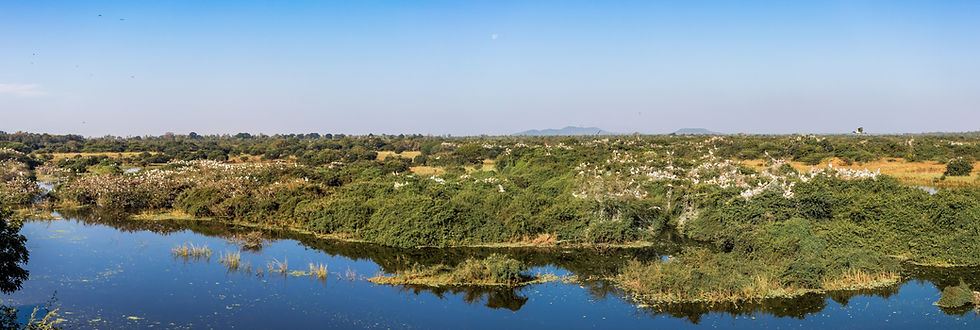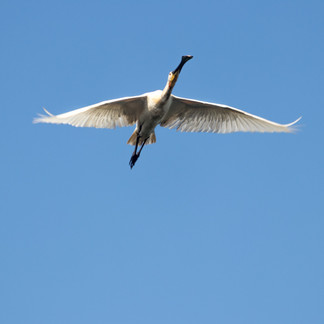Feathered Visitors
- Mahesh V
- Feb 4, 2018
- 5 min read

There is something which makes bird watching an intriguing process. For starters, you need a lot of time. Then you need to know what you are looking at. And once you spot the bird, you need to wait for the moment when you can snap and take that one shot that your personal expectation. Sometimes you might spot what you've already seen and sometimes you are completely surprised by nature which will show you something you've never seen before. But every click will make you realise how different life is every moment and it is so important to look forward to every moment as if something great is going to happen in that very moment.
Bird watching to me is that 'looking-forward-to' moment. Every time I scan the landscape through my lens, I believe something is going to happen now. Some pictures make me realise, hey, I never looked forward to taking this and some make me realise, yes, this is what I wanted. And Nature is not so kind after all. You might be looking to the east and all the fun will be in the west. But still, bird photography will never give you the 'give-up' feeling. It will always be telling you - just wait for some more time, that moment is somewhere round the corner and it will happen. If not today, then tomorrow. But just hang in there.
I came back from Pulicat Lake and Nelapattu Bird Sanctuary with such feelings. I don't follow a specific photography genre so I am always ready to explore all genres. So when Chennai Trekking Club organised this photo-walk, I was excited and registered as soon as the link was made available. The original plan was to cover Pulicat Lake and chase the lovely Flamingos who grace the lake with their presence. But since we had the whole day, we decided to explore Nelapattu as well.
Pulicat Lake
We started early on Feb 4. We decided to meet at CMBT at 4:45 AM and start for Pulicat by 5:00 AM. We were a group of 14 who had bikes and car at their disposal and we started our trip bang on time. The Nelapattu sanctuary opens at 8 AM so we decided to spend some time in Pulicat first and then leave for Nelapattu. We reached Pulicat Lake around 6:30 AM. With ample time in our hands, we started stopping at every small bridge over the lake to see flocks of birds fishing around. The birds did not trust us a bit. A slight move made them fly away from the place and made me realise how we, the supposedly the most intelligent form of life on Earth, have managed to create this impression that we are the most dangerous species around. Storks, Pelicans, Terns all lived in harmony. But when humans came near them, it created chaos, panic and lack of trust made them fly away. All had the same unanimous opinion of us - Untrustworthy. Sad but true.
Nevertheless, some of them were kind enough to understand and come back. Pulicat lake was low on water. Locals said it did not rain much there. It reminded me of Rann of Kutch. One can walk on the seabed to reach the nearest puddle of water. On paper, the lake is around 760 Sq Kms. But it looked like less than 10% was covered with water. However the places that had water were occupied by aquatic birds. We spotted Painted Storks, Spot-Billed Pelicans, Common Terns and Cormorants. The weather was cool and walking around was a pleasure. Nature posed brilliantly for us. The rays of the sun kissed the land and water painting the world around us in gold. Those moments were worth preserving.
Around 7:30 AM, we had covered the entire stretch of Pulicat Lake leading upto Satish Dhawan Space Research Centre. Sadly, we did no spot a single Flamingo. It seems we were late. The flamingos flock to the place in Dec and Jan. We probably could have walked on the river bed and gone closer to the water body or hired a boat and waded deeper into the water. But we had to head back to Nelapattu and hence did not venture further as the locals were not very hopeful either. We started our drive to Nelapattu Sanctuary which is around 25 Kms from the place.
Nelapattu Bird Sanctuary
This bird sanctuary is in Nelapattu which is the border town between Tamil Nadu and Andhra Pradesh. This place is the breeding spot for Spot-Billed Pelicans, Open-billed Storks and the Black-headed Ibis. Much like Vedanthangal, this place also had viewing points and watch towers to catch the birds up-close. About 189 bird species can be found at Nelapattu Bird Sanctuary, 50 of which are migratory. In addition to the Spot-Billed Pelicans, Open-billed Storks and the Black-headed Ibis, it is an important breeding site for white ibis, night heron, and little cormorant. Other migratory water birds that visit the sanctuary include pintail, common teal, dabchick, shoveler, coot, spot-bill duck, grey heron, darter, black-winged stilt, and garganey gadwall (source: Wiki)
The ideal time to visit Nelapattu Bird Sanctuary is between October and March as the weather then is extremely pleasant which gives greater opportunity to the visitors to enjoy the sight of birds in their natural habitat. The sanctuary is open from 8AM to 5PM daily. The entry fee for Adult is Rs. 10 and Camera is Rs. 100.
Tips for Travelers
Start early if you can. The best time to see the birds is early in the morning when they are fetching their meals. The birds are early risers. You can be as well, if you like to enjoy watching them fish and feed
Pulicat is approx 80kms from Chennai and Nelapattu is 100kms from Chennai. The roads are in good condition and well maintained. You will come across two toll booths on your way
Wear dull clothes that blend with the surroundings
Radio sets and musical instruments are not allowed inside the sanctuary. Food and water is allowed. Please make sure to keep the surroundings clean
Keep as quite as possible
Try not to go too close to the birds. Like I mentioned, we have not put their doubts to rest about humans. You will end up scaring them
Carry a good pair of binoculars to help to watch them without going too near
Birds can be fascinating creatures with much to offer those who care to study them. Watching birds can reveal things about nature and the beauty that exists in nature. Bird watching itself is fun and an ideal solitary sport that settles you mind down and opens up your senses. When you are in the zone, the nature is your friend.
Identifying birds can be challenging and birds are energetic animals. One needs a quick eye to spot as many details as possible in short moment.
Some useful bird watching tips
Keep your eye on the bird. Follow the bird through your eyes first, monitor its behavior before you follow it through your lens
Listen for bird calls and sounds
If possible, make note of their facial markings and characteristics
Observe their wings, color, length, bills etc.
Study their movements and flying patterns
Most importantly, try registering your observations. Will help you every time
So, if you want to live in a point in time where every moment surprises you and you are curious to know and learn, try bird watching. I assure you wont be disappointed.

































